Education News - February 2008
This newsletter highlights the latest curriculum related teaching resources, student activities and statistical tools that have been developed by ABS Education Services as well as other ABS resources that are useful for schools.
Contents
- CensusAtSchool 2008
- New Geography Classroom Activities
- An Idea for the Classroom
- ABS Economic data
- Teacher Librarian Workshops in Melbourne
- International Statistical Literacy Competition
- Conference Participation
- Recently Released Publications
- Contact details
CensusAtSchool 2008 has begun!
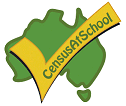 Make sure that your students don't miss out on this engaging, interactive and versatile classroom activity. Check if your school is registered. (If not, download a registration form from the website.) The online questionnaire, which is suitable for students from Grade 5 to Year 12 is open until 4 July, 2008.
Make sure that your students don't miss out on this engaging, interactive and versatile classroom activity. Check if your school is registered. (If not, download a registration form from the website.) The online questionnaire, which is suitable for students from Grade 5 to Year 12 is open until 4 July, 2008.
Students respond to questions on topical issues such as climate change, water use, bullying and use of technology as well as lifestyle questions such as breakfast habits, participation in sport and favourite music. There are also direct measurement questions (height, belly button height, arm span). The very popular reaction timer and concentration games from the 2006 questionnaire are both included again.
Teacher feedback from 2006 indicates that the questionnaire can be easily completed within one class period. For smooth running of the class it is suggested that all measurements are taken beforehand.
When the data base is available in July, students will be able to compare different groups (eg by age, gender, state and even country) on many different variables. Data from CensusAtSchool 2006 will also be available to allow comparisons across time.
The versatility of CensusAtSchool means that whether you are teaching primary or secondary students, and irrespective of the curriculum area, using CensusAtSchool can make your teaching more engaging, relevant and effective.
New Geography Classroom Activities
Two new Geography classroom activities that use Census 2006 data, have been added to the Education Services website. Activity Geo_09 uses MapStats to develop geospatial concepts and Geo_10 utilises Community Profiles to examine and compare social and demographic characteristics of areas.
The figure below has been taken from Geo_10. It shows the age and sex breakdown for the suburb of Peppermint Grove, WA. How does this population pyramid compare with that for the whole of Australia? What are the similarities and differences? What may account for the large number of 10 to 19 year old females? The classroom activity also compares this suburb with Footscray in Victoria. It is suggested that you choose the suburb in which your school is located for further comparison.
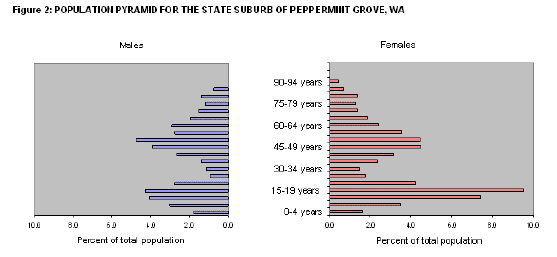
Future classroom activities will look at transects across urban areas, the demographic changes associated with inner city residential growth, sea change and rural decline.
 |
 |
An Idea for the Classroom
Another of the Real Data datasets on the ABS Education Services pages looks at the country of birth of Australia's permanent residents for the years 1996, 2001 and 2006. This is rich information that could be used in a social studies classroom when examining changes in communities.
You could ask your students to examine the graph and name 3 countries from each region (refer to the Dataset if necessary). They could map these countries and their capitals and/or code a world map according to the regions.
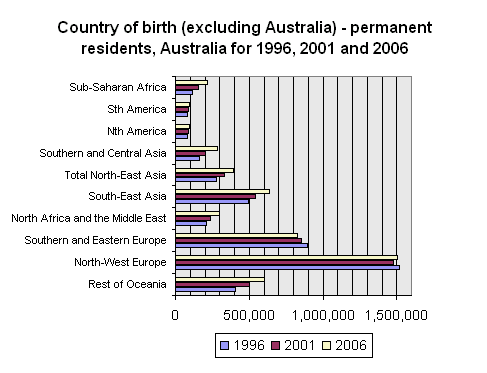
The country of birth of permanent Australian residents has changed between 1996 and 2006. You could ask your students which regions show the greatest numerical change? Which regions show the greatest proportional change? What explanations might there be for these changes? By looking at the Dataset itself, you can also see the variation within regions. You could ask your students to discuss these variations.
Not all regions have seen an increase. The number of permanent residents who were born in Southern and Eastern Europe has declined. What may explain this change?
There are many more explorations that could be developed from this data set. You could discuss the benefits (and costs) of living in multicultural Australia. You could also compare this information with migration information (see Education News Sept, 2007) or ancestry data from the Census 2006.
Do you have a classroom idea that uses ABS data or ABS Education products? Let us know at education@abs.gov.au and we can share it around Australia.
ABS Economic Data
 A key role of the ABS is to collect, collate and disseminate economic data and this data provides an ongoing, valuable and reliable resource for teachers. A key role of the ABS is to collect, collate and disseminate economic data and this data provides an ongoing, valuable and reliable resource for teachers.
For example Australian System of National Accounts, 2006-07 (Cat No. 5204.0) includes a number of sections aimed at improving the understanding of economic information. For example it includes a section called 'Understanding How to Use National Accounts', as well as a Frequently Asked Questions section. There is also a comprehensive glossary under the Explanatory Notes tab.
Teacher Librarian workshops in Melbourne
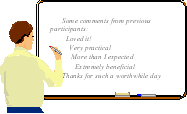 Two free, hands-on workshops for teacher librarians will be run in the ABS Melbourne office on Tuesday 4 and Friday 7 March, 2008. Feedback from a similar event last year was unanimously positive, with teachers commenting that it was 'very practical', 'loved it' and that it was 'more than I expected'. Two free, hands-on workshops for teacher librarians will be run in the ABS Melbourne office on Tuesday 4 and Friday 7 March, 2008. Feedback from a similar event last year was unanimously positive, with teachers commenting that it was 'very practical', 'loved it' and that it was 'more than I expected'.
Each workshop runs from 10:00 am until approximately 2:30 and lunch is provided.
Places are limited so if you are interested, contact Education Services.
Similar workshops may be run in other states in future - watch this space
International Statistical Literacy Competition
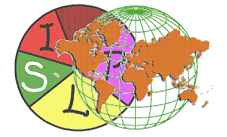 Students from age 10 to 18 from around the world have begun entering the International Statistical Literacy Competition, which is again being coordinated by the International Statistical Literacy Project (ISLP) of the International Association for Statistics Education (IASE). Students from age 10 to 18 from around the world have begun entering the International Statistical Literacy Competition, which is again being coordinated by the International Statistical Literacy Project (ISLP) of the International Association for Statistics Education (IASE).
Entry is free, but students must be registered by a teacher. Already there are entries from South Africa, Portugal, Italy, China, Brazil, Argentina, New Zealand, Spain, Mexico, Chile, USA, Colombia, Costa Rica, Sri Lanka, Indonesia, Nigeria and Russia.
The main aim of this project is to encourage students to both understand and enjoy statistical data analysis and show them how statistics is an indispensable tool for understanding the world. Another aim is to encourage teachers to discover the statistical literacy resources that exist in their country.
 Further information (and pictures from the 2007 competition) is available from the web site: www.stat.auckland.ac.nz/~iase/islp/competition Further information (and pictures from the 2007 competition) is available from the web site: www.stat.auckland.ac.nz/~iase/islp/competition
|
Conference Participation |
| ABS Education Services attended the biennial Social Educators of Australasia conference in Newcastle in January, 2008. Pat Beeson, (ABS teacher consultant) presented a paper entitled 'Exploring the Nature of Spatial Citizenship'.
In March Pat will be presenting at the WALIS International Forum for teachers in Perth. The focus will be the variety of ABS products that may be used with GIS in the classroom. This will be the first time that the WALIS forum has had a stream specifically for teachers.
Staff from ABS' NSW office will represent ABS Education Services at the Australian School Librarians Association (NSW branch) conference in late March.
ABS Education Services is also planning workshops at the Maths Association of South Australia conference (23-24 April, 2008). One will examine how data at the postcode level can be fed into a GIS system to produce meaningful and engaging data; the other will demonstrate some of the many ways to use CensusAtSchool data in the Maths classroom.
Keep an eye out for ABS Education Services at conferences you attend. Let us know how you are using ABS data, which resources are most useful and what further resources you would like. |
 |
Recently Released Publications
Year Book Australia 2008 (cat. no. 1301.0)
This flagship publication provides a comprehensive
and detailed statistical overview of various aspects of the population, economy, and social conditions in Australia, it includes chapters dealing with Australia's geography and climate, government, international relations, defence, education, and health and welfare support systems.
The hardcopy edition is available at a special discounted price of $69.30, if ordered by schools through Education Services.
Sports and Physical Recreation: A Statistical Overview, Australia 2008 (cat. no. 4156.0)
Provides a statistical overview of sports and physical recreation in Australia. Topics covered include output of the sports and physical recreation sector, employment in sports and physical recreation, government outlays on recreation, international trade in sports and physical recreation goods, attendances at sporting events and participation in sport and recreational activities.
Contact details
How to contact ABS Education Services
Free Call: 1800 623 273
email: education@abs.gov.au
Mail: GPO Box 2796
Melbourne, 3001
 Print Page
Print Page
 Print All
Print All